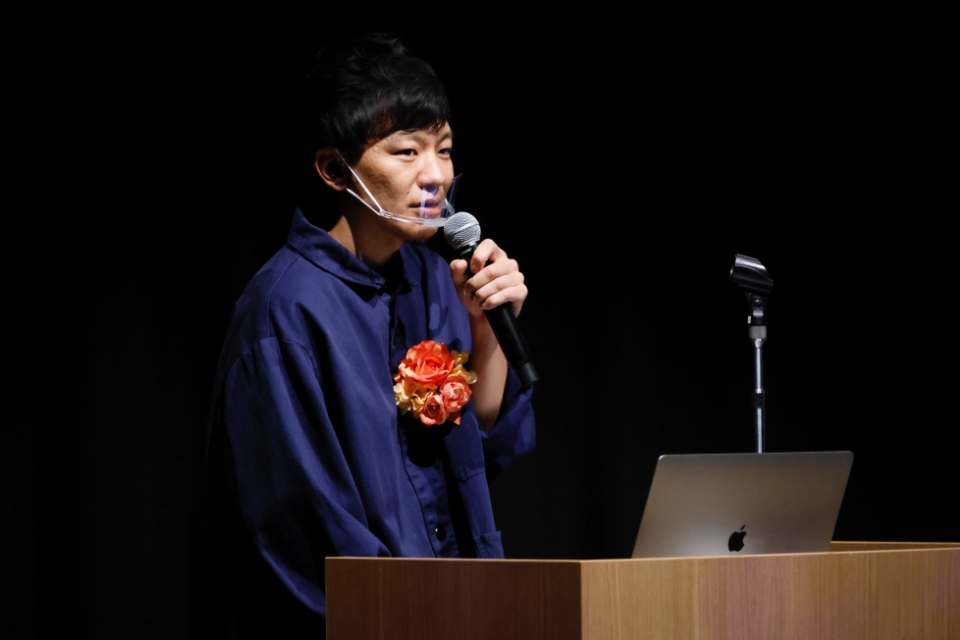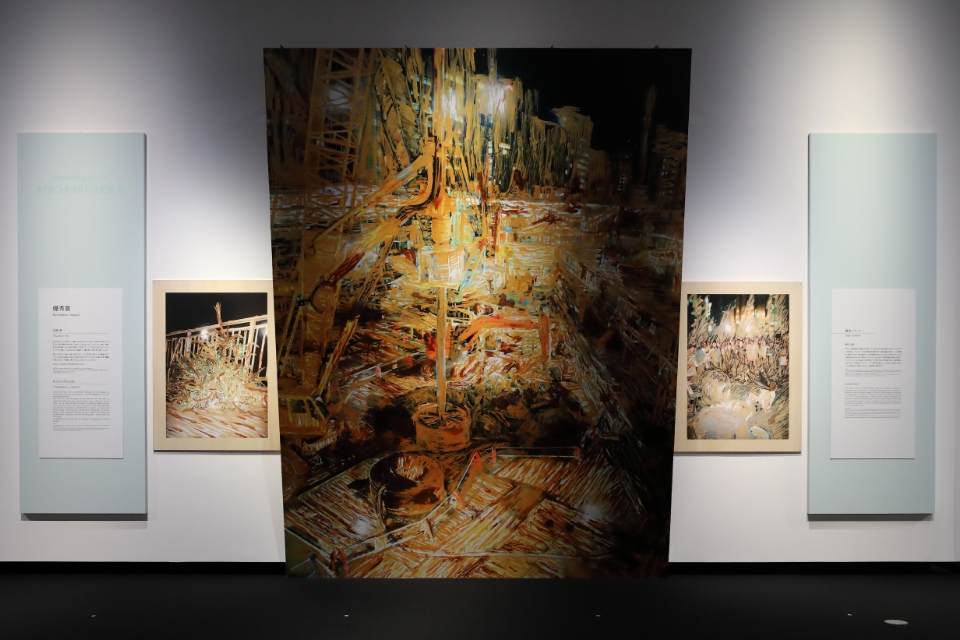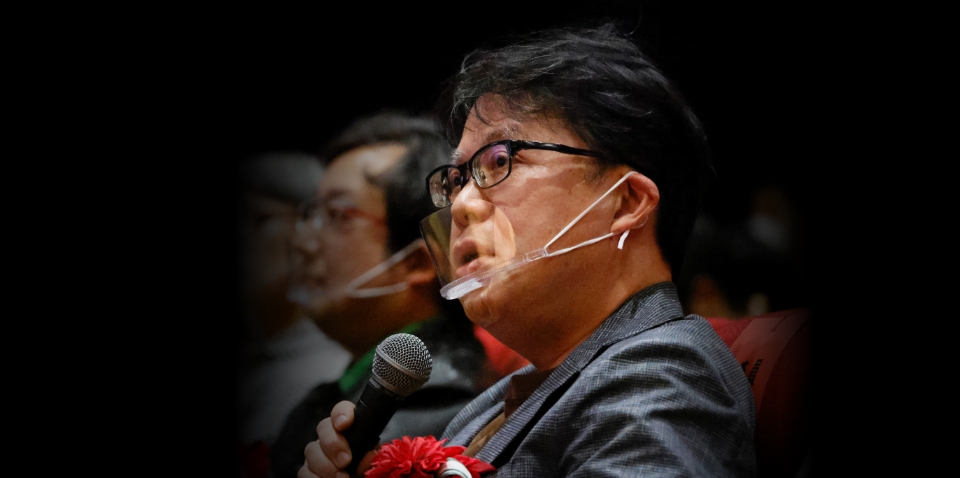PRESENTATION
This work develops on a solo exhibition of the same name I held this February in a basement gallery in Shibuya. Shibuya happens to be situated above one of the largest continually flowing springs in Tokyo. The gallery itself would likely be submerged if not for pumps under the foundation, constantly pumping water out three sump pits and into the sewage system. The exhibition made it possible for visitors to see the otherwise unseen flow of water under the city by pumping water up from the first sump pit, through the gallery, and into the second sump pit.
My inspiration for the work was the first gallery I visited this year. A cold draft entered the building because the doors were left wide open to prevent the spread of COVID-19. And thus I had the rare experience of viewing pictures while feeling a winter chill. Due to a change in circumstances, something external — that until now had been kept at bay — had penetrated inside. The experience was like running into something I was not meant to meet, and I thought there's something to this. Seeing the pandemic transform the unusual into the everyday led me on a search for things we can only envisage while exactly in the middle of the extraordinary and the ordinary. This work started from that search.
From a hunch that there might be something in the culverts — which provide an image of the outer extremities of a city — I asked a person familiar with the area to show me around a culvert. It was warm inside the culvert, despite being mid-winter, and a thunderous roar from the flow of water echoed throughout the pitch-black tunnel. I was struck how this world existed just one layer below the city in which we normally live. That the everyday and the unusual are clearly separated into spaces above and below ground was interesting to me, and it dawned on me that urban development had chosen this form.
After returning to the surface, we caught sight of a massive construction project in front of Shibuya station. I found it strange that a place where the future is being built looks so much like ruins from a distant past.
When I first saw it, I was amazed by the rust-like color of the mud that I would later paint on my photos. The mud is apparently imbued with the color by the iron content in the Kanto loam layer. Long ago, before the Shibuya River was diverted into culverts, the muddy water was called shibuiro, reddish-brown, which some say is the origin of the name Shibuya. In any case, this is the original color of Shibuya and I wanted to show the mud to people, as I felt it was inundated with all manner of things. So I dug up some of the mud and painted it on photos of Shibuya to craft this work. For the photos, I chose construction sites, aloe plants left behind by urban development, and other locales where the everyday and the unusual are juxtaposed, and where things normally unseen appear to dominate the frame.
What I wanted to talk about today is not urban theory, but rather the things you can only envisage in the instant between the extraordinary and the ordinary. If people sense this palpably in my work and not through words, I would be thrilled.
As for my exhibit, it would have been great to have used actual mud and water, but I had to consider what I could do in the limited wall space. I wanted to express a sense of urgency, so I chose to tilt and display the large photographs with a forward slant.


When I saw your exhibit, I also wished I could have seen the original with the mud painted on it. Painting on photographs has been a trend lately, and it isn't particularly special. But what surprised me was the original exhibition that inspired this work. I think the gallery that let you hold such an exhibition was amazing. Is the use of photographs an absolute must for you?
(Mitsuoka)
I don't think photographs are an absolute must: I think of them like a comedy duo placed in the middle of a rakugo performance. But I've always been intrigued by photography, especially the sensation of how it shows you the answer before the question. Even though you only have to press the shutter button to take a photo, it feels like the photo leaves you behind before you can comprehend what you took. That's why I started painting on photos, in an attempt to come to terms with what I had taken — trying to catch up with the photo in a way. I see painting as a natural development of that form.

I did some research long ago on the Shibuya River. The impression I remember was the culverts were more like a limestone cave than historic ruins, with the rainwater that leaks in from above making the concrete look like stalactites. My experience back then was if you put your ear against the wall of the cave near the Hachiko statue, you could hear the sounds in the basement floors of department stores. That gave me the sense of being just a single wall away from daily life in Shibuya. On this side, a modern cave, and on that side, a modern capitalist space.
In your work, you do not place these spaces adjacent to each other; instead you superimpose an element from the underground on top of your work. Unfortunately, this superimposition didn't feel very realistic to me. I think the idea that the surface space and underground space are distinct yet in the same location, without being superimposed, is closer to reality. How do you view the reality of coating the photos with mud? Coating on something that is normally separate is a kind of intrusion, right. If a large earthquake struck Shibuya, Shibuya would likely liquify and muddy water from below would cover the surface. That would be my conjecture. In that case, I think it would have been better to splatter the mud on more randomly to give the impression of a liquifying city.
(Mitsuoka)
When I describe this work to people, I use the word tracing rather than coating. The subjects in my photos were things that appealed to me at that particular moment. I tried to better understand them by tracing them with my own hands later on. That was the idea I was after. But when it comes to the reality of the city and the culverts, then you are correct that this technique doesn't reflect their reality. I'll use your suggestion in my future work.

Judges' comments and Q&A
Daisuke Yokota (selector)
Yours is an enigmatic work in many ways, so I listened to your presentation with great interest. You have a unique and finely tuned mindfulness focused on everyday things, such as the oddness you felt about the wind blowing into that gallery or your choice, based on a hunch, of a culvert after a series of coincidences. Instead of presenting your serpentine experience directly in documentary form, you first let the experience develop and unfold in your mind. Then you took a more abstract route and recreated your experience as a new experience in your work. To me, that was captivating.
I was wondering though, was your decision to focus on culverts really an intuitive one? Also, what do you think about the various limitations you faced for this exhibition?
(Mitsuoka)
I had been curious about culverts for some time, and I had wanted to travel down one. But I had no idea on my own what I should be cautious about down there, so I hadn't gone. In my mind, the feeling I got from the wind that blew into the gallery — that something from the outside had entered the inside and that the inside had been opened up to the outside — overlapped in a way with the culverts that lead outside the city. So I sensed this was the time to go visit one.
As for my exhibit, if I could do anything and if I could use real mud and water, I had a daydream of putting together a huge installation with enormous photos with water splashing on them that you could view from both above and below. Even if I couldn't use water, I think it would have better, given the size, if I had caked on real mud. If I couldn't do that and if I had to use copies, I thought it would have been better to make the photos at least 1.5 times taller to convey more of the sense of urgency I wanted to project.